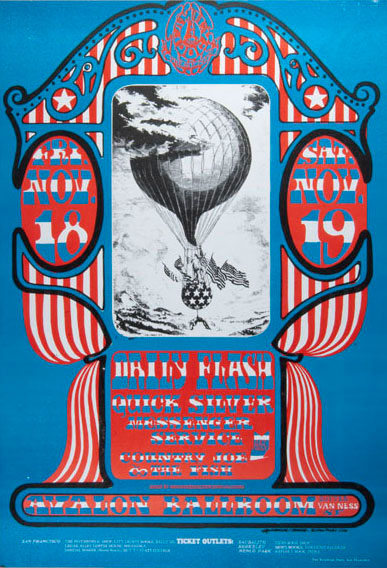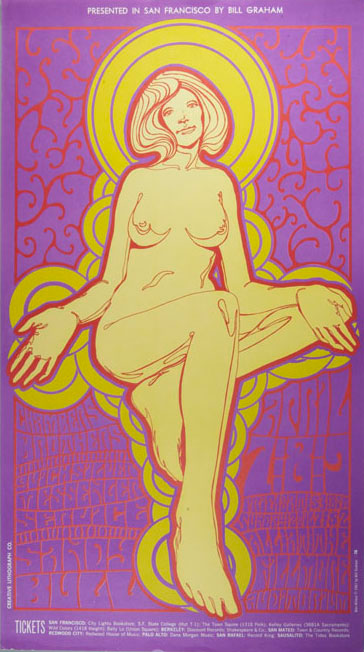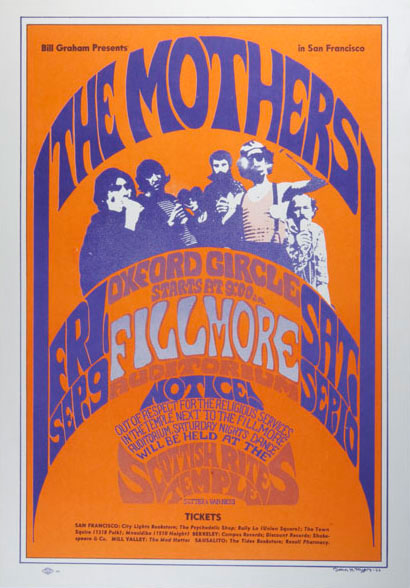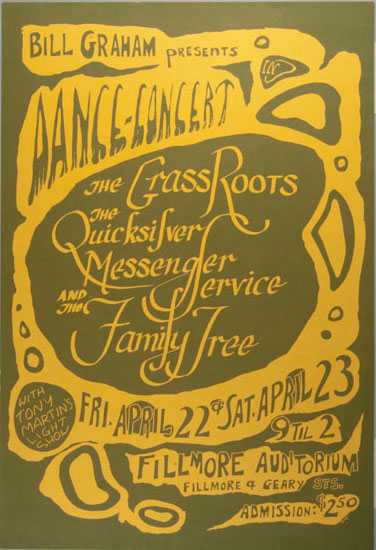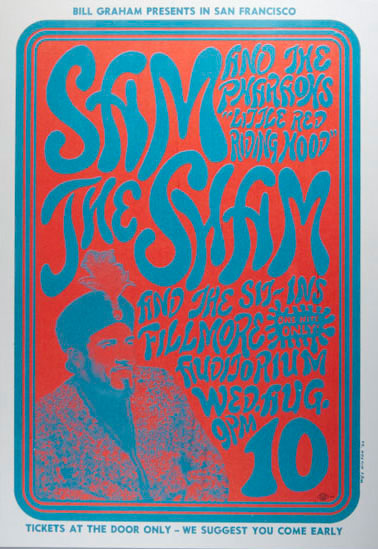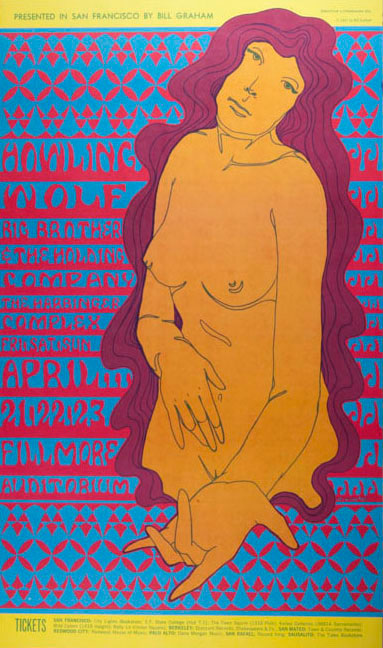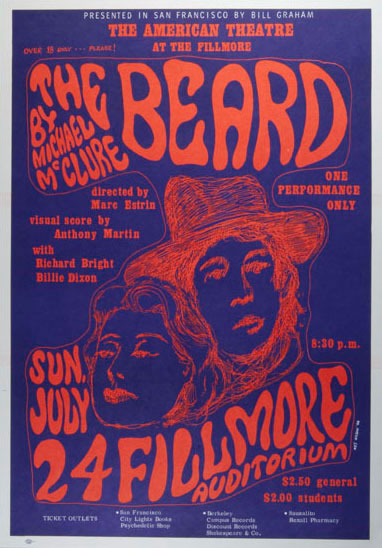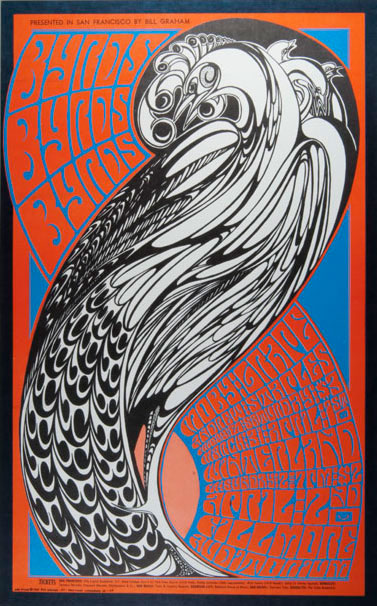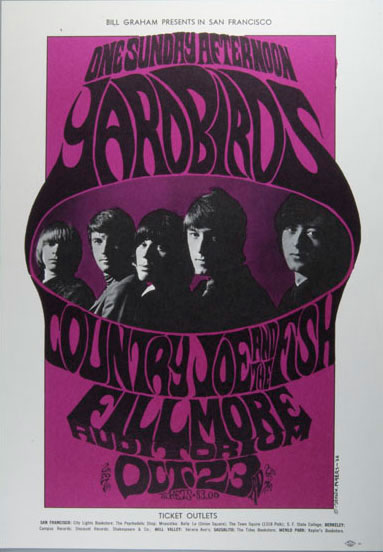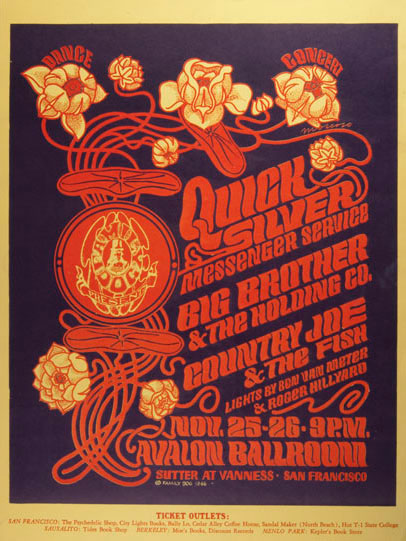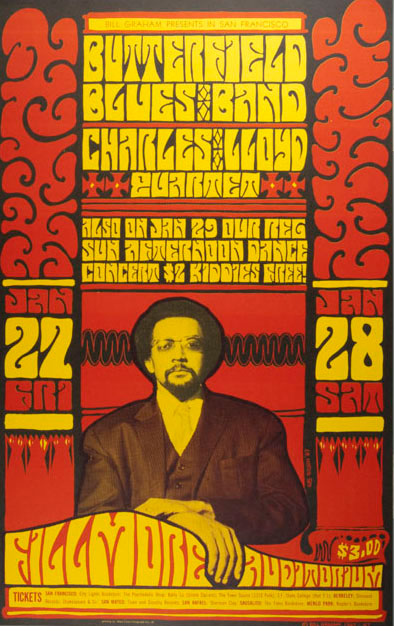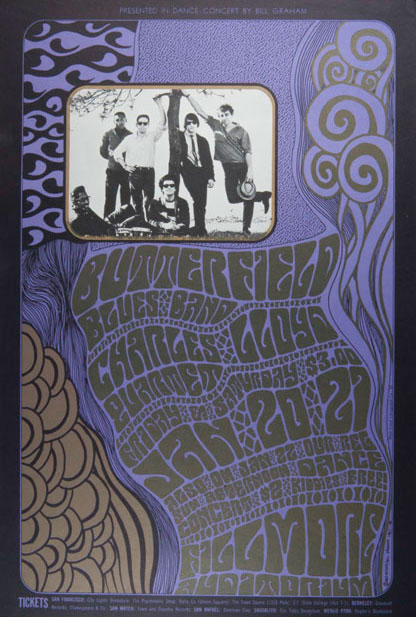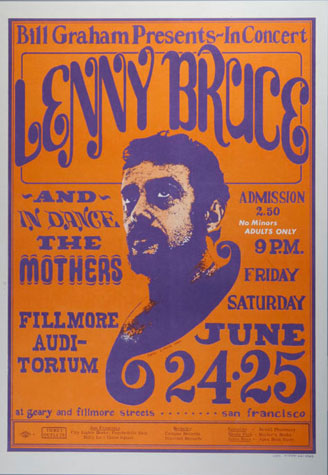November 17 – December 15, 2011
Curated by Greg Flood
Curator's Statement
Finding a point of entry into the 1960s can be difficult for those who did not live through it. Events were happening fast, new cultural attitudes were being formed and the results would change the course of social culture in America, and its west coast in particular. The easiest way for most to enter is through the music. The rock posters created for the concert series’ presented in San Francisco by The Family Dog Collective and Bill Graham Presents embody this cultural change as it happened. The visual style that emerged was unlike anything ever seen in America before and which had not been present in European poster art since before WWII. The collection presented here presents the opportunity to see this style as it emerged and view its evolution, and the evolution of the artists involved, from the beginning of 1966 to the middle of 1967.
The music most remembered from the late 1960’s is the psychedelic rock which got its start in the San Francisco Bay Area. The roots of the music from this period come from a number of sources. Examples include early rock and roll, the British influence, but most importantly the blues rock and folk music waves that had taken hold in the late 1950’s and early 1960’s. The folk music wave in particular had created venues for alternative music in the bay area at the UC Berkeley Campus in 1958 and at San Francisco State College (now University) in 1961. These folk venues would prove to be some of the first places that the new psychedelic sound was heard in the bay. By 1966 emerging bands like Jefferson Airplane were being heard there.
In late 1964 - early 1965, a group of young people got together to live cooperatively in a house at 2111 Pine Street in San Francisco. Among this group, which would later become The Family Dog Collective, was the young artist, helicopter mechanic, and former motorcycle racer Alton Kelly. Kelly had left his life in Connecticut in 1964 to discover what San Francisco had to offer. He was doing collages when he moved into the house and later began painting elements of the moldings and insets in day-glow colors – a form of early psychedelica.
In the late spring of 1965, a Virginia City, Nevada, bartender at the Red Dog Saloon named Chandler Laughlin was looking for a band for a new venue he had just bought. A young band called The Charlatans was a perfect fit and the friends of the band traveled up to the bar to help reconstruct the insides of it. Alton and many of the house members were a part of this trip. The Charlatans played the whole summer there and when the fall came there were stirrings among the members of the 2111 house that they should put in the same kinds of happenings in San Francisco. This is when The Family Dog Collective formally came into existence. Soon after their return, the first concerts were held at a variety of venues.
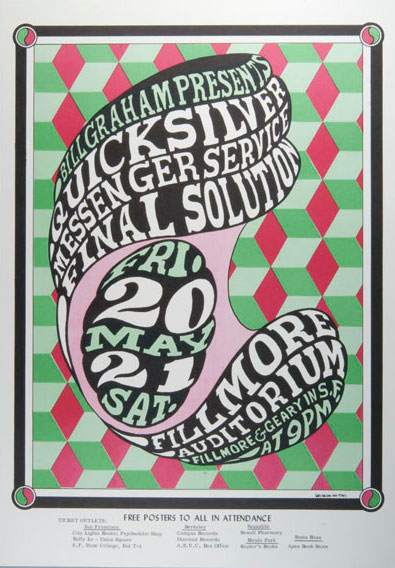 Alton Kelly was their natural pick for the creation of the early Family Dog concert posters. These posters (not shown in the exhibition) are hand drawn lists of the bands performing in a variety of different fonts, with little to no imagery or other detailing. The Family Dog Collective changed leadership, shortened its name, and moved the concerts to more public venues under Chet Helms. Helms stuck a deal with Bill Graham, another promoter of concerts, to share the Fillmore Auditorium, where the landmark series of concerts and posters began for both promoters. Later, The Family Dog, as it was now known, moved its concerts to the Avalon Ballroom. The posters here by Alton Kelly are from those he did for The Family Dog concert series after it had moved to the Avalon.
Alton Kelly was their natural pick for the creation of the early Family Dog concert posters. These posters (not shown in the exhibition) are hand drawn lists of the bands performing in a variety of different fonts, with little to no imagery or other detailing. The Family Dog Collective changed leadership, shortened its name, and moved the concerts to more public venues under Chet Helms. Helms stuck a deal with Bill Graham, another promoter of concerts, to share the Fillmore Auditorium, where the landmark series of concerts and posters began for both promoters. Later, The Family Dog, as it was now known, moved its concerts to the Avalon Ballroom. The posters here by Alton Kelly are from those he did for The Family Dog concert series after it had moved to the Avalon.
At the beginnings of both the Family Dog and Bill Graham concerts series, both promoters shared the graphic artist Wes Wilson for the creation of their posters. Wilson’s work for both, while being created simultaneously, would display very different characteristics. The Family Dog posters had folk influences in its imagery and its type faces. TheBill Graham Presents series, however, displays greater freedom with the lettering. Wilson created 11 of the first 12 posters of the numbered series for The Family Dog, with number 11 by Victor Moscoso, after which he worked exclusively for Graham. He also created the iconic Family Dog badge logo which appears on all of the numbered series posters. It can be most easily seen in FD-33, where it has been enlarged to be the central image of the poster. It is made up of the image of the Native American fur trader smoking a joint, surrounded but the words The Family Dog Presents.
Wilson is the first artist to really explore and define what has come to be known as the psychedelic art movement. His inspiration came from a number of different sources. Wilson has said that he most likely chose his first colors from his experiences on LSD. A big source of his design inspiration for him was the catalogue for the 1965 Jugenstil and Expressionism exhibit at the University of California. The catalogue included Viennese Secessionist lettering, which greatly inspired him. Wilson and Bill Graham’s relationship ended at the end of the summer of 1967, with his last poster being BG-62. All of Wilson’s posters for Bill Graham Presents are presented here in the order of their creation, allowing the viewer to watch the psychedelic style, as well as Wilson’s, grow and evolve.
 After Wilson left The Family Dog, posters for the collective were made by a number of artists. The four of the five Family Dog posters presented here were created by both Alton Kelley and the artist Stanley Mouse. Mouse was a well known artist in the hot rod circuit before he settled in San Francisco; his favorite tool being the airbrush. He traveled to San Francisco and then traveled back to his home town of Detroit to figure out how to get around being drafted for the war. He returned to SF in early 1966 and met up with Alton Kelley, after which he became a part of the Family Dog. That June is when he began collaborating with Kelley on the posters. In Mouse’s words the posters are a “conglomeration of everything that we had learned, or had seen, up to then.” Most of the work in the collaborative posters Mouse sees as being his, and a number of historians agree with him. Kelley’s specialty was collage and photos, which do not appear in many of their collaborative works.
After Wilson left The Family Dog, posters for the collective were made by a number of artists. The four of the five Family Dog posters presented here were created by both Alton Kelley and the artist Stanley Mouse. Mouse was a well known artist in the hot rod circuit before he settled in San Francisco; his favorite tool being the airbrush. He traveled to San Francisco and then traveled back to his home town of Detroit to figure out how to get around being drafted for the war. He returned to SF in early 1966 and met up with Alton Kelley, after which he became a part of the Family Dog. That June is when he began collaborating with Kelley on the posters. In Mouse’s words the posters are a “conglomeration of everything that we had learned, or had seen, up to then.” Most of the work in the collaborative posters Mouse sees as being his, and a number of historians agree with him. Kelley’s specialty was collage and photos, which do not appear in many of their collaborative works.
When Wilson left Bill Graham, his post was taken over by Bonnie MacLean. MacLean had been Graham’s secretary for a number of years, and had provided additional support for putting on the shows. She created one poster at the very beginning of the Bill Graham series, BG-0, which is actually the fourth in the series. This work shows her style before the influence of Wes Wilson. Her work after taking over the production of posters shows a remarkable assimilation of his style of lettering, with unique imagery of her own. In between this first poster and Wilson’s departure, she experimented with the Wilson style and honed her sensibility on the chalkboards at the Fillmore auditorium, thus enabling her to pick up where Wilson had left off.
The Bill Graham series presented here shows not only the development of one artist, but also of the movement he inspired in a number of others. In addition to Alton Kelley, Stanley Mouse, and Bonnie MacLean, both Peter Bailey and John H. Myers are represented here by multiple works. Combined, their works here embody the birth of a movement that has had lasting impact on popular culture and in the fine arts.
Curator: Greg Flood
November, 2011
Acknowledgements: Guest Curator Greg Flood would like to give his thanks and gratitude to Stephanie Sanchez and Michael McGinnis for the invitation to curate this show. He would also like to thank collector Richard Reisman for his generosity in lending his collection for the exhibition, without which this show would not be possible. He would also like to thank Ron Casentini for his able assistance and encouragement in the development of show and his support in making it happen. Special thanks go to Renata Breth, Carla Stone, and the students of the exhibition design class for their assistance in organizing and mounting the show.


